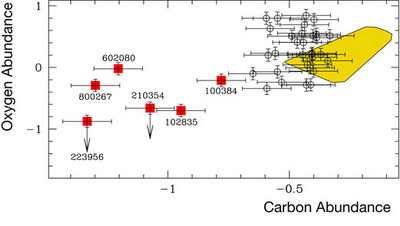Stellar vampires unmasked

Astronomers have found possible proofs of stellar vampirism in the globular cluster 47 Tucanae. Using ESO's Very Large Telescope, they found that some hot, bright, and apparently young stars in the cluster present less carbon and oxygen than the majority of their sisters. This indicates that these few stars likely formed by taking their material from another star.
"This is the first detection of a chemical signature clearly pointing to a specific scenario to form so-called 'Blue straggler stars' in a globular cluster", said Francesco Ferraro, from the Astronomy Department of Bologna University (Italy) and lead-author of the paper presenting the results.
Blue stragglers are unexpectedly young-looking stars found in stellar aggregates, such as globular clusters, which are known to be made up of old stars. These enigmatic objects are thought to be created in either direct stellar collisions or through the evolution and coalescence of a binary star system in which one star 'sucks' material off the other, rejuvenating itself. As such, they provide interesting constraints on both binary stellar evolution and star cluster dynamics. To date, the unambiguous signatures of either stellar traffic accidents or stellar vampirism have not been observed, and the formation mechanisms of Blue stragglers are still a mystery.
The astronomers used ESO's Very Large Telescope to measure the abundance of chemical elements at the surface of 43 Blue straggler stars in the globular cluster 47 Tucanae.
They discovered that six of these Blue straggler stars contain less carbon and oxygen than the majority of these peculiar objects. Such an anomaly indicates that the material at the surface of the blue stragglers comes from the deep interiors of a parent star. (In the core of stars slightly more massive than the Sun, hydrogen is converted into helium using carbon, nitrogen and oxygen as 'catalyst') Such deep material can reach the surface of the blue straggler only during the mass transfer process occurring between two stars in a binary system. Numerical simulations indeed show that the coalescence of stars should not result in anomalous abundances.
In the core of a globular cluster, stars are packed extremely close to each other: more than 4000 stars are found in the innermost light-year-sized cube of 47 Tucanae. Thus, stellar collisions are thought to be very frequent and the collision channel for the formation of blue stragglers should be extremely efficient. The chemical signature detected by these observations demonstrates that also the binary mass-transfer scenario is fully active even in a high-density cluster like 47 Tuc.
"Our discovery is therefore a fundamental step toward the solution of the long-standing mystery of blue straggler formation in globular clusters," said Ferraro.
Measurements of so many faint stars are only possible since the advent of 8-m class telescopes equipped with multiplexing capability spectrographs. In this case, the astronomers used the FLAMES/Giraffe instrument that allows the simultaneous observation of up to 130 targets at a time, making it ideally suited for surveying individual stars in closely populated fields.
Source: European Southern Observatory





















